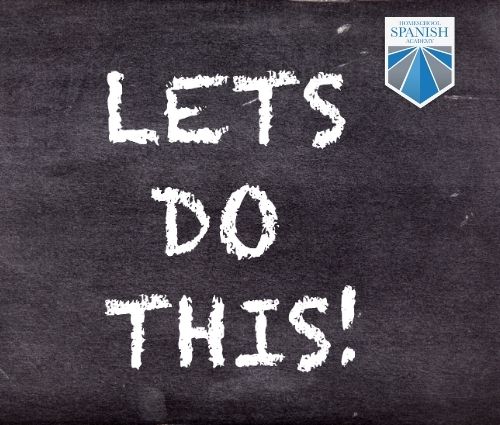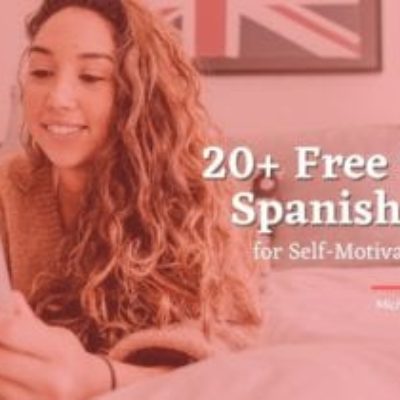
Read in Spanish IV: Free Spanish Texts for High School Students
Welcome back to our “Read in Spanish” Blog Series for High School Students! This exciting series comprises 8 blog posts bursting with original and entertaining Spanish stories that grow in complexity as you move through them. Each piece in our series aligns with our high school curriculum standards and allows students to practice reading grammar elements they’ve just learned. You are currently on blog post #4.
Go to:
- Read in Spanish I: High School Curriculum 1A, “The Basics of Spanish Part 1”
- Read in Spanish II: High School Curriculum 1B, “The Basics of Spanish, Part 2”
- Read in Spanish III: High School Curriculum 2A, “Introductory Grammar and Irregular Verbs, Part 1”
If you’re not yet part of Homeschool Spanish Academy’s high school program, don’t worry. The only criteria here is to enjoy what you read in Spanish!
In the following stories, which follows High School Curriculum 2B, “Introductory Grammar and Irregular Verbs, Part 2,” you’ll exercise your foundations in the following Spanish skills:
- Verbs ser, estar, and haber
- Direct objects in sentences
- Indirect objects in sentences
- Personal “a”
- Prepositions
- Intransitive verbs
If you’re learning Spanish on your own, check out the following articles to prepare you for the stories below:
- Ser vs Estar: Using Adjectives with These Spanish Verbs
- Direct Object Pronouns in Spanish
- Indirect Object Pronouns in Spanish: 10 Great Online Exercises
- How to Use the Personal A in Spanish: Do’s and Don’ts
- In, On, and By: A Beginner’s Guide to Spanish Prepositions
Read in Spanish: Free Spanish Texts for High School Students
Let’s get started with what you came here for! After you read each story, try to answer the comprehension questions. If you get stuck on any of them, leave us a comment below and we’ll have an answer for you in no time!

1. Trabajando Juntas
Amelia y Paula son compañeras de clase. De vez en cuando, ellas deben trabajar juntas. El día de hoy, Amelia y Paula deben trabajar juntas en una tarea. Ellas deben leer un texto y encontrar las respuestas a las preguntas.
“¡Hola Amelia!” dice Paula.
“Hola Paula,” dice Amelia.
“¿Cuándo quieres trabajar en la tarea?” pregunta Paula.
“Yo no puedo hoy,” dice Amelia. “Podemos trabajar mañana.”
“Está bien,” dice Paula. “Puedes visitar mi casa después de clase.”
“¡Sí!” dice Amelia. “Yo te visito mañana.”
Amelia y Paula quieren hacer su tarea. Ellas quieren resolver la tarea y mostrar un buen trabajo. Al día siguiente, Amelia visita a Paula después de clase.
“¡Bienvenida a mi casa!” dice Paula.
“¡Gracias!” dice Amelia.
“¿Quieres que te sirva algo de tomar?” pregunta Paula.
“Sí, gracias,” dice Amelia.
“Está bien,” dice Paula. “¿Me puedes ayudar?”
“¡Sí!” dice Amelia.
Paula le sirve agua a Amelia. Amelia la ayuda. Amelia y Paula toman agua y platican antes de empezar a trabajar en la tarea.
“¿Qué hacemos primero?” pregunta Paula.
“Tal vez podemos leer el texto de primero,” dice Amelia.
“Está bien,” dice Paula.
“El texto está en el libro,” dice Amelia.
“Préstame el libro,” dice Paula.
“Aquí tienes,” dice Amelia.
Amelia le da el libro a Paula. Ellas leen el texto juntas. Durante la lectura, ellas toman notas. Paula subraya el libro de Amelia. Luego, ellas revisan las preguntas que deben contestar.
“¡Son muchas preguntas!” dice Paula. “Esto nos va a costar contestar.”
“¡No!” dice Amelia. “Nosotras podemos contestar estas preguntas.”
“¡Tienes razón!” dice Paula.
“¿Te recuerdas de la lectura?” dice Amelia.
“Sí,” dice Paula.
“¡Perfecto!” dice Amelia. “Yo puedo anotar las respuestas.”
“Está bien.”
“Dame el lápiz, por favor,” dice Amelia.
“Aquí tienes,” dice Paula.
Paula le da el lápiz a Amelia. Ellas trabajan juntas para contestar las preguntas. No les cuesta a ellas completar la tarea. Ellas prestaron atención.
“Muéstrame las respuestas,” dice Paula.
“Aquí están,” dice Amelia.
“A mí me parece que están bien,” dice Paula.
“¡Sí!” dice Amelia. “Terminamos la tarea.”
“¡Genial!” dice Paula.
Al día siguiente, Amelia y Paula le presentan la tarea a la maestra.
“¡Buen trabajo!” dice la maestra. “¿Cómo trabajaron juntas?”
“Nosotras leímos el texto juntas,” dice Paula.
“Paula me ayudó con las respuestas y yo las apunté,” dice Amelia.
“¡Muy bien!” dice la maestra.
“¡Gracias!” dicen ellas.
Amelia y Paula están orgullosas. Ellas hicieron un buen trabajo con la tarea.
“¡Lo hicimos!” dice Amelia.
“¡Sí!” dice Paula “La maestra estaba orgullosa de nosotras,”
Amelia le da un abrazo a Paula. Ellas trabajaron muy bien juntas. Ellas esperan volver a trabajar juntas.
Know What You Read in Spanish
Try to answer each of these questions in Spanish using the text above.
- How do Amelia and Paula know each other?
- Where do Amelia and Paula work on their homework together?
- What do they do first when they start the homework?
- Was it hard for them to answer the questions?
- How do Amelia and Paula feel after they turn in the homework to their teacher?
- What do Amelia and Paula hope to do in the future?
(Click here to check your answers.)
2. Las Vacaciones
Eduardo y su familia están de vacaciones. Ellos volaron de su país hacia Guatemala. Ellos visitan Antigua Guatemala. Eduardo está emocionado. Él quiere ver todos los nuevos lugares.
Eduardo y su familia llegan de noche a Guatemala. Ellos no pueden visitar ningún lugar cuando es de noche. Ellos van a su hotel para descansar.
“Eduardo,” dice Papá. “¿Puedes ayudarme?”
“Sí,” dice Eduardo.
“Llévate esas maletas a nuestra habitación,” dice Papá. “Yo me llevo las otras.”
“Está bien,” dice Eduardo.
Eduardo y su papá se llevan todas las maletas a su habitación. Después de llevar las maletas, Eduardo y su familia se acomodan. Eduardo se acuesta en su cama y se va a dormir.
Al día siguiente, ellos se despiertan muy temprano. Ellos quieren desayunar antes de visitar la ciudad. En el restaurante, los meseros son muy amables.
“¡Bienvenidos a Guatemala!” dice el mesero.
“¡Gracias!” dice Mamá.
“Les regalamos una bebida,” dice el mesero.
“Son muy amables,” dice Mamá.
“Muchas gracias,” dice Papá.
Las bebidas que los meseros les regalaron son deliciosas. A Eduardo le gusta desayunar en restaurantes. Tal vez él va a poder comer en muchos restaurantes durante su visita.
Después de desayunar, Eduardo y su familia deciden visitar la ciudad. Ellos visitan muchas tiendas y mercados. A Eduardo le gusta ver todos los colores de Antigua Guatemala. La ciudad es muy bonita.
“Yo quiero que nos tomen fotos,” dice Mamá.
“Pregúntale a alguien,” dice Papá.
Mamá le pregunta a alguien que les tome una foto. Papá, Mamá y Eduardo se preparan para la fotografía.
“Sonríe Eduardo,” dice Mamá. “Nos van a tomar una foto.”
Eduardo sonríe. La personas les toma la foto. Mamá está feliz con la foto. Ellos continúan viendo el resto de la ciudad. Después de un largo tiempo, Eduardo tiene hambre. Él quiere almorzar pero no sabe a dónde ir. Papá escoge un restaurante con comida típica de Guatemala. Toda la comida se ve deliciosa. A Eduardo le da sed. Él le pide un vaso con agua al mesero.
“¿Me puede traer un vaso con agua?” pregunta Eduardo.
“Sí, yo te lo puedo traer,” dice el mesero.
“Muchas gracias,” dice Eduardo.
El mesero le trae el vaso con agua a Eduardo. Eduardo se toma el vaso con agua muy rápido. Él estaba muy sediento.
Después de almorzar, Eduardo y su familia deciden regresar al hotel. El hotel tiene una piscina y Eduardo quiere nadar en ella. Eduardo nada en la piscina hasta tarde.
“Estas vacaciones son geniales,” dice Eduardo.
“Me alegra que te gusten,” dice Mamá.
“Las voy a recordar por siempre,” dice Eduardo. “Tal vez vuelva a visitar Guatemala otra vez.”
“Puedes ver otros lugares de Guatemala,” dice Papá.
“¡Sí!” dice Eduardo. “Eso me gustaría.”
Know What You Read in Spanish
Try to answer each of these questions in Spanish using the text above.
- Where do Eduardo and his family go for vacation?
- How does Eduardo help his dad when they arrive?
- What did the waiter give the family for free?
- Where did the family go after breakfast?
- What does Eduardo’s family do after lunch?
- How does Eduardo feel about his vacation?
(Click here to check your answers.)
Improve Your Skills
If you’d like to put your Spanish skills to the test with a friendly certified teacher, sign up for a free trial class with us right now. Your confidence will skyrocket when you realize that you are actually speaking Spanish with a native!
Discover more about learning Spanish with HSA:
- What Are the Different Levels of Language Proficiency?
- The Best Homeschool Spanish Curriculum at HSA
- Tracing the Beginnings of Homeschool Spanish Academy
- Learning Español: Tailored Classes for Schools
Click here to go to the next in the series: Read in Spanish V.

Want more free Spanish lessons and fun content? Check these out!
- The 25 Most Useful Spanish Phrases You Need to Lear Today
- 50 Useful Spanish Transition Words for Everyday Speech and Writing
- Master the 18 Spanish Tenses (and Take Our Cheat Sheet With You)
- All About Adverbial Clauses in Spanish
- Top 20 Guatemalan Words and Slang Expressions You Should Know
- The Ultimate Guide to the Differences Between ‘Pero’ and ‘Sino’ in Spanish
- A Guide to Double Negatives in Spanish
- Ver Conjugation: Free Spanish Lesson, Exercises, and PDF
Answer Key:
1. Trabajando Juntos
- Amelia and Paula are classmates.
- They meet at Paula’s house to do their homework together.
- First, they read the text, underline important parts, and take notes.
- They thought it would be, but it wasn’t hard for them to answer the questions.
- They feel proud to have done a good job.
- They hope to work together again on homework in the future.
2. Las Vacaciones
- Eduardo and his family go to Antigua, Guatemala for vacation.
- Eduardo helps his dad carry in the luggage to their hotel room.
- The waiter gave the family a free drink.
- The family visited the city of Antigua, exploring stores and markets.
- After lunch, they go back to their hotel and swim in the pool.
- He thinks it’s great and he will remember it forever.
- A-Z: Beginner Spanish Word Lists for Kids + Free Flashcards - February 23, 2023
- Intermediate Spanish Reading Practice - April 5, 2022
- Free Spanish Lessons for Kids (Science, History, Basics and More) - February 21, 2022




